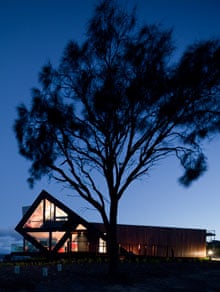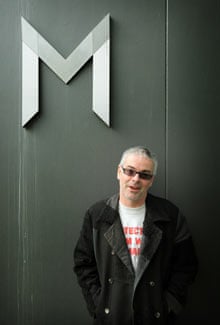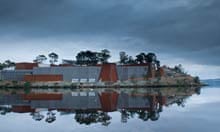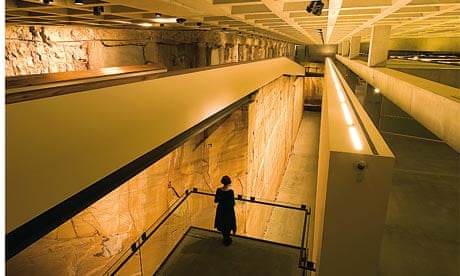"Please see reception if you are planning a pool party or a ritualistic orgy." The advice is typical of David Walsh's irreverence. Walsh is the owner of eight designer glass-and-steel guest pavilions and a vineyard outside Hobart, Tasmania. Instead of the "Do not Disturb" sign, guests can hang a "Don't fuck with me" sign on the doorknob.
The luxurious riverfront pavilions, a restaurant and live music events are ways in which Walsh has been attracting visitors to stay on his 3.5-hectare estate, Moorilla, for longer than a swift tasting. He had a museum of antiquities on site for a while, too. Nobody came, he admits. Yet his new idea is to create Australia's largest private art gallery. Sex, death, myth and religion are the central themes and its very air threatens to be thick with ripeness and decay.
Walsh, a mathematics whizz, is probably the state's richest man, having developed a gambling system that successfully and repeatedly beats the house. He's now taking his biggest gamble yet – building a new museum in the bowels of the earth to house his considerable personal art collection. Billed as a "subversive Disneyland", the A$76m (£47m) Museum of Old And New Art (Mona) will open to the public on 21 January just after Mofo, a music festival curated by ex-Violent Femmes bassist and fellow Tassie resident, Brian Ritchie.
One of the stand-out exhibits will be a piece by Jannis Kounellis (Untitled) featuring rotting sides of beef which will be fed into the artificial digestion tract of Cloaca, a separate work by Wim Delvoye. Cloaca is a machine that reproduces, with gross exactitude, excrement. Handily, you will be able to fortify yourself for the assault on the senses beforehand at the museum's underground bar.
Walsh, 49, is an old rocker in a T-shirt, jeans and shades, who was raised by his mum in a council house on the other side of Mount Wellington, the peak that dominates the colonial port. He dropped out of university, but has since built up a successful winery, brewery and tourism business – as well as a A$100m art collection.

Moorilla is on a private peninsula in the Derwent River, 15 minutes outside Hobart. It was originally established by Italian immigrant Claudio Alcorso in 1958. Walsh used to look at the place from his old house across the water and, in the 1990s, he acquired it along with the riesling, gewürztraminer, chardonnay, pinot noir and cabernet wines it produces. He's since added Moo Brew beer and fine dining at the Source. But Mona – his "unmuseum" – is central to Walsh's vision.
The museum has been created by excavating a giant hole in the sandstone bluffs of Moorilla. From above, it is barely there – its entrance is via a shaft cut into a floor of a remodelled heritage villa on the cliff top. But approaching from the water it looks formidable – a fortress with impenetrable bunkers of sandstone-coloured waffled concrete and panels of rusted steel. There's nothing bijou about it – Mona is similar in size to both Queensland's and South Australia's state art galleries.
Walsh hopes a good chunk of Tasmania's 910,000 annual visitors will make a pilgrimage to his temple to secularism. The best way to arrive will be up the River Derwent from central Hobart on the new rivercat service, docking at the foot of a flight of stairs cut into the cliff. If it feels like arriving on a Greek island, that's deliberate – Naxos was the model. You ascend to this antipodean acropolis, negotiating a children's playground, a Sunday market and walk across a tennis court before reaching the museum entrance – Walsh's aim is to challenge ideas about what great museums should be like right from the outset.
Australia can be a very conservative place, but Tasmania's cheap living and craft traditions have made it an attractive home to artists and other nonconformist downsizers from the mainland. The island state is reinventing itself from a place dedicated to shredding old-growth forests for paper into somewhere that cherishes its pure, natural beauty. Once-shameful convict-period prisons have been declared Unesco world heritage sites, and luxury eco-lodges seem to open each year.

After you have climbed the steps to the villa entrance, you descend again to a subterranean canyon. From here, Walsh's architect, Nonda Katsalidis, has built three gallery floors extending out of a rock face. The ceiling, a grid of concrete coffers (deep recesses), reads like a brutal take on classicism. Concrete piles driven into the living rock are dripping caryatids. A rusted-steel staircase snakes between floors.
Moving through the windowless voids is deliberately bewildering. A personal audio device is both the only guide to the art and a way for Mona to track you – it can tell how long you stand in front of each work. Walsh thinks he will swap around the 10 most popular and least popular pieces each week.
A circular tunnel leads under the foundations of a second historic house to a separate pavilion built to house Sternenfall, Anselm Kiefer's 6.5m-high stack of lead books.
The collection combines Walsh's antiquities (he has ancient coins worth more than any of his paintings) with Australian and international contemporary works and he is happiest creating dialogues between the periods – Egyptian mummies will be on nodding terms with YBAs.
One gallery is especially devoted to sex and death, with a bordello-red velvet curtain and peep holes to objects through a gold-leaf wall. If the virtually-all-glass guest pavilions are about exhibitionism, this is about voyeurism. "It's the opportunity to mess with your head," admits Walsh, as is the gallery bar: "I like the idea of people having a couple of beers and looking at the art, having a couple more and changing their mind."
Mona's labyrinth is rich with myth and mortality. Even in the roomy cinema, a Christian cross of black seats is set out among the red. There are artworks like Julius Popp's Bit Fall, a delicate waterfall where words appear digitally in the tumbling raindrops. Then there's serenity in Wilfredo Prieto's Untitled (White Library), where a gallery is entirely lined with thousands of white books. Every page is blank. It's one of David Walsh's favourite pieces.

Walsh reckons Mona might outdo the National Gallery of Australia in Canberra in terms of visitor numbers but he adds, not entirely convincingly, he's not bothered if visitors don't come at all. That's not the point, he says. "It's fun to make a big, complex, elaborate joke – it's about subversion, but it's not too serious. It is a counterpoint to the Met and Moma. I'm not trying to bestow wisdom. It is just me doing stuff." He also says he doesn't care if rising sea levels drown his temple to secularism in decades to come.
That's not convincing either, of course: Walsh is keen to raise hell and debate and to show how art can reveal what we try to hide about ourselves. He's planning more architecture – a warehouse gallery in Hobart's docks and more accommodation at Moorilla itself, taking his spend on the estate to A$100m: "Eventually I want to build a hotel and make it a cohesive whole. Everything is a function of Mona: Moo Brew, the pavilions, the function centre. I'd like the hotel entrance to be via a shaft through the rock from the waterfront. But I need a lot of people to come first."
Those with sensory overload can retreat from Mona to the guest pavilions with their sybaritic bathrooms and the peaceful prospect of the wide Derwent and the hills beyond. But even here, there's no escaping Walsh's obsessions entirely. Beneath original artworks ancient and modern, and the giant photo-murals of naked couples making out, you can browse books such as Blasphemy: Art that Offends while grazing on dishes whose ingredients include abalone, periwinkle and smoked oyster oil.
On the floor of one pavilion is a large black rug on which writing, picked out in red, reads: "Apropos of nothing, it's nice to have you here. Thanks, we need the money."
Essentials
Mona opens to the public on 21 January. The boat service to Moorilla begins on 23 January, and costs A$15 return from Brooke Street pier on Hobart waterfront. There is limited on-site parking, but people with disabilities can arrange this by calling +61 3 6277 9900.
Mona's guest-pavilion rates range from A$490 to A$950 per night, including breakfast in the Source restaurant or in your pavilion. Entry to Mona is free (mona.net.au). Qantas (qantas.com) flies daily from London Heathrow to Hobart via Melbourne from £960 including all taxes and surcharges. Valid for departure 16 April - 20 June 2011
